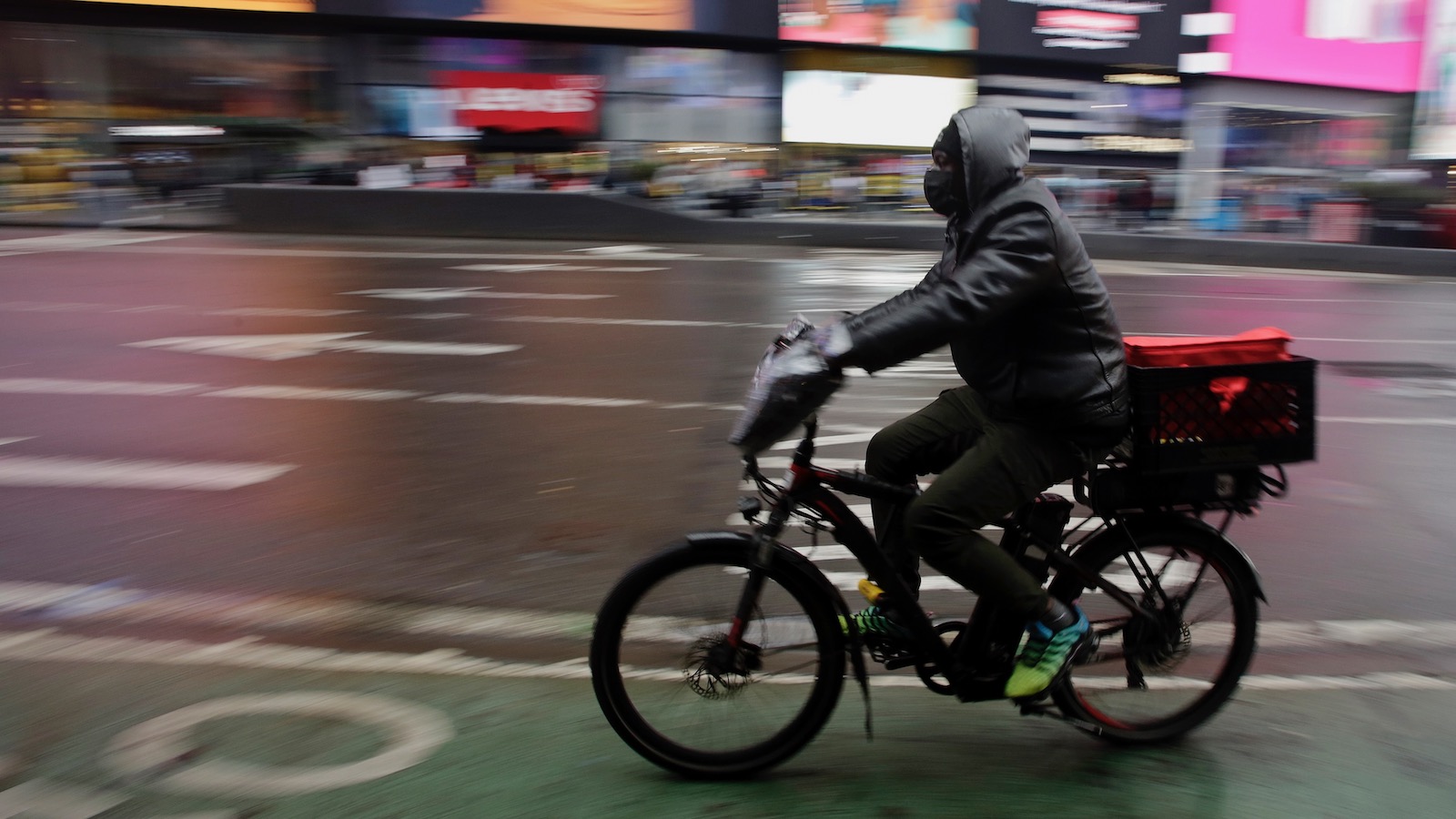Last year, San Francisco voters did something exceedingly rare in car-crazy America: They closed two miles of a coastal highway to vehicles, creating a sprawling park for pedestrians, joggers, and cyclists. Of course, furious residents in the neighborhood bordering the erstwhile highway voted last month to recall their representative at City Hall for championing the transformation and, to their minds, creating a traffic nightmare on side streets — even though commute times in the area have grown by just a few minutes since the closure.
The battle in the City by the Bay is emblematic of the inflection point facing cities nationally. As more electric vehicles hit the road, the temptation is to invest heavily in the infrastructure — roads, highways, parking lots — that will preserve the status quo of prioritizing cars over people. Meanwhile, the e-bike market is skyrocketing — and, according to some studies, outpacing electric cars — providing an even more environmentally friendly travel option. The question now is: Do officials double down on deadly car-centric urban design, or do they rethink cities to encourage people to ditch four wheels for two?
Secure · Tax deductible · Takes 45 Seconds
Secure · Tax deductible · Takes 45 Seconds
Cities and states throughout the country are taking steps to make existing infrastructure more accommodating to those who prefer to pedal. They are lowering vehicle speed limits, building designated bike lanes, providing charging, and ensuring underserved neighborhoods don’t get left behind. All of this has been a big change in just the past few years, given that some locales didn’t regulate e-bikes at all until the late 2010s, said Leigh Ann Von Hagen, director of the Voorhees Transportation Center at Rutgers University. “All states have seen the writing on the wall,” she said.
The promise of the e-bike is that it can help people of every age. Parents are carting children around on beefy models with built-in bins. Workers can use them to get to and from their jobs. Shoppers can slap saddle bags over the rear fender to haul groceries. And elderly folks, who may not be confident in their ability to operate a conventional pedaller, can use them in lieu of driving. “I have an uncle in Tennessee who started riding an e-bike when he retired because he just didn’t want to drive to the store anymore,” Von Hagen said.
In addition to that lowering of carbon emissions — how much exactly will depend on the city and the rate of e-bike adoption, but the drop may be somewhere around 12 percent — there’s also the harder-to-quantify health benefits of people exercising more. Plus, fewer cars spewing pollution improves air quality and public health. EVs, too, release their own form of pollution: Because they’re heavier than combustion cars, their tires and brakes produce more microplastics that sully the air and wash out to sea.
Drivers may experience range anxiety about their electric vehicle not having the juice to reach their destination, but the opposite is true for e-bikers. Older people or those with medical conditions might avoid conventional cycling because they worry about having the energy to make it somewhere, especially if there are hills in their way. With e-bike ranges far exceeding the average distance that riders are traveling (around 6 miles), range anxiety can be higher for those providing their own pedalling power. “When we do interviews with people, they will use the e-bike on eco, or even off, when they’re on flat terrain, and as soon as they get to that hill, they consistently report putting it up to the maximum,” said Jessica Bourne, an active travel researcher at the University of Bristol in the UK. “As one participant described it: It’s just flattening their journey.”
You can see the potential for e-bikes to replace cars in how their riders compare to those on conventional bikes. Given that e-bike users have the option to let the motor do all the work, you might assume that they’re burning fewer calories. But research has shown that riders tend to travel significantly farther on e-bikes, meaning they’re getting about as much physical activity as those taking shorter trips on conventional bikes.
Put another way: It’s less exertion, but more time spent exercising and running errands. “Once you account for increased frequency and increased duration and distance traveled, they spend longer on the bike overall, so they’re actually expending more energy on a weekly basis,” Bourne said. “That’s why they have more potential to substitute for motorized vehicles.”

Indeed, several studies have shown that people are already replacing car trips with e-bike rides on a wide scale. And the more bike-friendly cities make themselves, the more people opt for two wheels: Between 2009 and 2014, commuting by conventional bikes and electric versions doubled in New York City and Washington D.C thanks in part to better bicycle infrastructure. E-bike sales in North America doubled between 2018 and 2021. (So too have e-bike and e-scooter related injuries increased, due largely to insufficient and unsafe infrastructure for riders.)
Established cycling havens like the Netherlands — where the average person rides 680 miles a year, despite the chill of winter — show just how much the built environment can influence travel choices. “In the Netherlands, we say there’s no bad weather — there’s only bad clothing,” said Joost de Kruijf, a travel behavior researcher at Dutch Cycling Intelligence. “Once you reach a kind of threshold where you do all your trips by bicycle, then it just becomes a habit.”
The challenge, though, is that e-bikes remain expensive — anywhere from around $1,000 to over ten times that amount — putting them out of reach of the people who could benefit the most. Low-income folks without cars would get access to more employment opportunities if they had e-bikes, Bourne said, because they can travel farther, and often more conveniently. Similarly, young people would have greater access to education opportunities at colleges beyond walking distance or transit routes. That’s especially true if they’re living car-free somewhere with poor public transportation, a problem known to researchers as transport poverty.
The solution, Bourne said, is to subsidize e-bikes. California, for instance, has provided up to $2,000 for low-income residents to buy them, though the program is no longer accepting applications. Denver has offered similar support. “If it’s going to benefit the planet and it’s going to reduce the cars on the road, then why don’t we provide the subsidies for e-bikes, as we do for electric cars?” Bourne asks. “It just seems bananas to me.”
In fact, studies have shown that rebates incentivizing EV purchases and rebates that incentivize e-bikes can be equally effective, both costing about a dollar per ton of avoided carbon dioxide emissions, at least in British Columbia. “The big difference is electric bike incentives come with a whole range of other co-benefits,” said Alex Bigazzi, a researcher in transportation engineering and planning at the University of British Columbia. “Whereas electric car incentives actually have some downsides, because we know it incentivizes even more driving, which makes congestion worse, and leads to more sedentary lifestyles, and leads to higher infrastructure costs.” (Some research has shown what’s called a rebound effect: Because electric vehicles are cheaper to operate, there can be a modest increase in total vehicle miles traveled.)
Indeed, in a report published last week, Bigazzi found that an e-bike rebate program in British Columbia helped recipients increase their cycling by 25 miles per week and reduce their car use by almost 11 miles. That, in turn, reduced emissions from travel by 17 percent per year, and increased physical activity during travel by 13 percent. Denver has said its popular e-bike voucher program has helped eliminate 170,000 vehicle miles traveled each week.
Experts say cities could also start to think about bike share programs as an extension of their public transportation system. “It really is a public benefit to get people from point A to point B without needing to park or drive a car,” said Kendra Ramsey, executive director of the California Bicycle Coalition. “There is an argument that having some sort of public subsidy, like public transit does, could greatly increase the number of folks that are able to use those systems.”

Cities where those programs already exist have seen success. Citi Bike in New York, run by the rideshare company Lyft, can be a model. With over a million riders every year, the program, which provides e-bikes and conventional bikes, is an accessible part of the city’s infrastructure.
Beyond making the bikes accessible, though, lies the challenge of making cities accessible for bikes. “I think the infrastructure needs to be somehow retrofitted for these faster mobility devices,” said Greg Rybarczyk, a professor at the University of Michigan-Flint, who studies e-mobility in the Detroit metro area. Making sure bikers know the rules of the road — and drivers know how to handle bikers — is critical, too. “I think there’s a long way to go in terms of driver education and marketing campaigns,” Rybarczyk said.
Even in Detroit, a historic center of American car manufacturing and car culture, e-bikes are picking up speed. But respondents to an e-bike user survey Rybarczyk conducted say that Detroit’s bike lanes aren’t well-maintained, putting them in unsafe situations. “The street sweepers don’t sweep the bike lanes. They don’t sweep the curbs as much. There’s a lot of debris on a lot of the routes in and around Detroit.” Maintaining – and, potentially, widening – bike lanes could do a great deal for e-bike users outside of the coastal megacities. So, too, could providing accessible charging and storage facilities, according to Amelia Neptune, who coordinates the League of American Bicyclist’s infrastructure evaluation program, Bike Friendly America.
“It’s not just, do you have bike parking, but do you have bike parking that allows for storage of e-bikes and charging of e-bikes?” Neptune said. Some “bike pod” companies are offering a potential solution for those who don’t have garages at home to store their bikes. And some of the colleges and universities that work with Bike Friendly America are beginning to offer e-bike parking options in their dormitories.
None of this is to say that cities have to obliterate car infrastructure to install bike-friendly routes. The gold standard, Bigazzi said, is protected infrastructure for bikes, in which a lane is physically separated from vehicles. Intersections, too, ideally have “protective movements,” when bikes and cars move through at different times.
Now cities face a choice: Invest in relatively cheap improvements to make cycling safer, thus encouraging people to cycle more, or double down on car infrastructure to accommodate EVs, thus encouraging people to drive more and endanger pedestrians and cyclists. “Cities can build out almost their whole bike network for the cost of rebuilding one or two freeway interchanges,” Bigazzi said. “So the cost of cycling infrastructure — even high-quality, protected infrastructure — is really relatively cheap, in terms of providing mobility in cities.”


